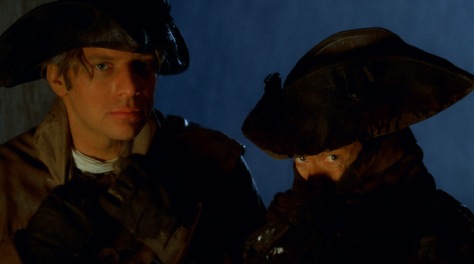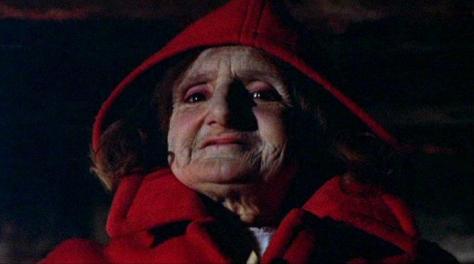By Dennis Hartley
(Originally posted on Digby’s Hullabaloo on October 28, 2017)

Since Halloween is coming up before my next weekly post, I thought I would do a little early trick-or-treating tonight (wait…you don’t think 61 is too old to trick-or-treat…is it?). Now, I enjoy a good old fashioned creature feature as much as the next person, but tonight’s recommendations largely eschew the vampires, werewolves, axe-murderers and chainsaw-wielders. Okay, we’ve got a few aliens, and (possibly) the odd zombie or ghost; but these are films where the volume knob on the sense of dread is left up the viewer’s discretion. The “horror” is in the eye of the beholder. Alphabetically:

Blue Velvet– Any film that begins with the discovery of a severed human ear, roiling with ants amid a dreamy, idealized milieu beneath the blue suburban skies instantly commands your full attention. Writer-director David Lynch not only grabs you with this 1986 mystery thriller, but practically pushes you face-first into the dark and seedy mulch that lurks under all those verdant, freshly mowed lawns and happy smiling faces.
The detached appendage in question is found by an all-American “boy next door” (Kyle MacLachlan), who is about to get a crash course in the evil that men do. He is joined in his sleuthing caper by a Nancy Drew-ish Laura Dern. But they’re not the most interesting characters. That honor goes to the troubled young woman at the center of the mystery (Isabella Rossellini) and her boyfriend (Dennis Hopper). Hopper is frightening as the 100% pure bat shit crazy Frank Booth, one of the all-time great screen heavies

Brotherhood of the Wolf– If I told you that the best martial arts film of the 1990s features an 18th-century French libertine/naturalist/philosopher and his enigmatic “blood-brother” (an Iroquois mystic) who are on the prowl for a supernaturally huge, man-eating lupine creature terrorizing the countryside-would you avoid eye contact and scurry to the other side of the street? Christophe Gans’ film defies category; Dangerous Liaisons meets Captain Kronos-Vampire Hunter by way of Crouching Tiger, Hidden Dragon is the best I can do. Artfully photographed, handsomely mounted and surprising at every turn.

Don’t Look Now– This is a difficult film to describe without risking spoilers, so I’ll be brief. Based on a Daphne du Maurier story, this haunting, one-of-a-kind 1974 psychological thriller from Nicholas Roeg (Walkabout, The Man Who Fell to Earth) stars Donald Sutherland and Julie Christie as a couple who are coming to grips with the tragic death of their little girl. Roeg slowly percolates an ever-creeping sense of impending doom, drenched in the Gothic atmosphere of Venice.

In the Realms of the Unreal– Artist Henry Darger is not usually mentioned in the same breath as Picasso, but he is a fascinating study. Darger was a recluse who worked as a janitor for his entire adult life. He had no significant relationships of record and died in obscurity in 1973. While sorting out the contents of the small Chicago apartment he had lived in for years, his landlady discovered a treasury of artwork and writings, including over 300 paintings.
The centerpiece was an epic, 15,000-page illustrated novel, which Darger had meticulously notated in long hand over a period of decades; it was literally his life’s work. The subject at hand: An entire mythic alternate universe populated mostly by young, naked hermaphrodites, whom he dubbed the “Vivian Girls”.
Although it’s tempting to dismiss Darger as a perv, until you have actually seen the astounding breadth of Darger’s imaginary world, spilled out over so many pages and so much canvas, it’s hard to convey how weirdly compelling it all is (especially if you view an actual exhibit, which I had the chance to see). The doc mixes Darger’s bio with animation of his work (actors read excerpts from the tome). Truth is stranger than fiction.

Liquid Sky – Downtown 81 meets Invasion of the Body Snatchers in this deeply weird 1982 sci-fi film. A diminutive, parasitic alien with a particular delectation for NYC club kids, models and performance artists lands on an East Village rooftop and starts mainlining off the limbic systems of junkies and sex addicts…right at the moment that they, you know…reach the maximum peak of pleasure center stimulation (the alien is a dopamine junkie?). Just don’t think about the science too hard.
The main attraction here is the inventive photography and the fascinatingly bizarre performance (or non-performance) by (co-screen writer) Anne Carlisle, who tackles two roles-a female fashion model who becomes the alien’s primary host, and a male model. Writer-director Slava Zsukerman also co-wrote the electronic music score.

Mystery Train-Elvis’ ghost shakes, rattles and rolls (literally and figuratively) all throughout Jim Jarmusch’s culture clash dramedy/love letter to the “Memphis Sound”. In his typically droll and deadpan manner, Jarmusch constructs a series of episodic vignettes that loosely intersect at a seedy hotel. You’ve gotta love any movie that has Screamin’ Jay Hawkins as a night clerk. Also be on the lookout for music legends Rufus Thomas and Joe Strummer, and you will hear the mellifluous voice of Tom Waits on the radio (undoubtedly a call back to his DJ character in Jarmusch’s previous film, Down by Law).

The Night Porter– Director Liliana Cavani uses a depiction of sadomasochism and sexual politics as an allusion to the horrors of Hitler’s Germany. Dirk Bogarde and Charlotte Rampling are broodingly decadent as a former SS officer and a concentration camp survivor, respectively, who become entwined in a twisted, doomed relationship years after WW2. You’d have to search high and low to find two braver performances than Bogarde and Rampling give here. I think the film has been misunderstood over the years; it frequently gets lumped in with (and is dismissed as) Nazi kitsch exploitation fare like Ilsa, SheWolf of the SS or Salon Kitty. Disturbing, repulsive…yet weirdly mesmerizing.

Upstream Color– Not that my original take on Shane Carruth’s 2013 film was negative (it leaned toward ambivalent), but apparently this is one of those films that grows on you; the more time I’ve had to ponder it, the more I have come to appreciate it (most films I see nowadays are forgotten by the time I get back to my car). To say it’s a riddle, wrapped in a mystery, inside an enigma is understatement. To say that it redefines the meaning of “Wha…?!” is more apt.
A woman (Amy Seimitz) is abducted, then forced to ingest a creepy-crawly whatsit that places her into a docile and suggestible state. Her kidnapper however turns out to be not so much Buffalo Bill, but more Terence McKenna. Long story short, next thing she knows, she’s back behind the wheel of her car, parked near a cornfield, and spends the rest of the movie retrieving memories of her bizarre experience in bits and pieces. As do we. You have been warned.

Venus in Furs (aka Paroxismus)– Jess Franco’s 1969 Gothic horror-psychedelic sexploitation fest was inspired by a conversation the director once had with trumpeter Chet Baker. Maria Rohm portrays a mysterious siren that pops into a nightclub one foggy night, and stirs the loins of a brooding jazz trumpeter (played with a perpetually puzzled expression by James “Moondoggie” Darren). Darren follows Rohm to the back room of a mansion, just in time to witness her ritualistic demise at the hands of a decadent playboy (Klaus Kinski) and several of his kinky socialite friends.
Sometime later, Darren is playing his trumpet on the beach, where Rohm’s body is seen washing ashore (you following this so far?). Next thing we know, she has “revived” and sets out to wreak revenge on her tormentors, in between torrid love scenes with Darren. Does she (or her “killers”) actually exist, outside of Darren’s mind? This visually arresting mash-up of Carnival of Souls and Blow-up is a bit dubious as to narrative, but heavy on atmosphere.

Wake in Fright– Considered one of the great lost entries from Australia’s own “new wave” movement back in the 70s, Ted Kotcheff’s unique psychological thriller concerns a burned-out teacher (Gary Bond) who works in a one-room schoolhouse somewhere in the Outback. Headed back to Sydney to visit his girlfriend over the school holiday, he takes the train to Bundanyabba, where he will need to lodge for one night.
“The Yabba” is one of those burgs where the clannish regulars at the local pub take an unhealthy interest in strangers, starting with the “friendly” town cop (Chips Rafferty) who bullies the teacher into getting blotto. This kick starts a lost weekend that lasts for days.
The ensuing booze-soaked debaucheries have to be seen to be believed; particularly an unnerving and surreal sequence involving a drunken nocturnal kangaroo hunt (a lengthy disclaimer in the end credits may not assuage animal lovers’ worst fears, but at least acknowledges their potential sensitivities). The general atmosphere of dread is tempered by blackly comic dialog (Evan Jones adapted from Kenneth Cook’s novel). Splendid performances abound, especially from Donald Pleasance as a boozy MD.
 Dead Man – Criterion Collection Blu-ray
Dead Man – Criterion Collection Blu-ray

















